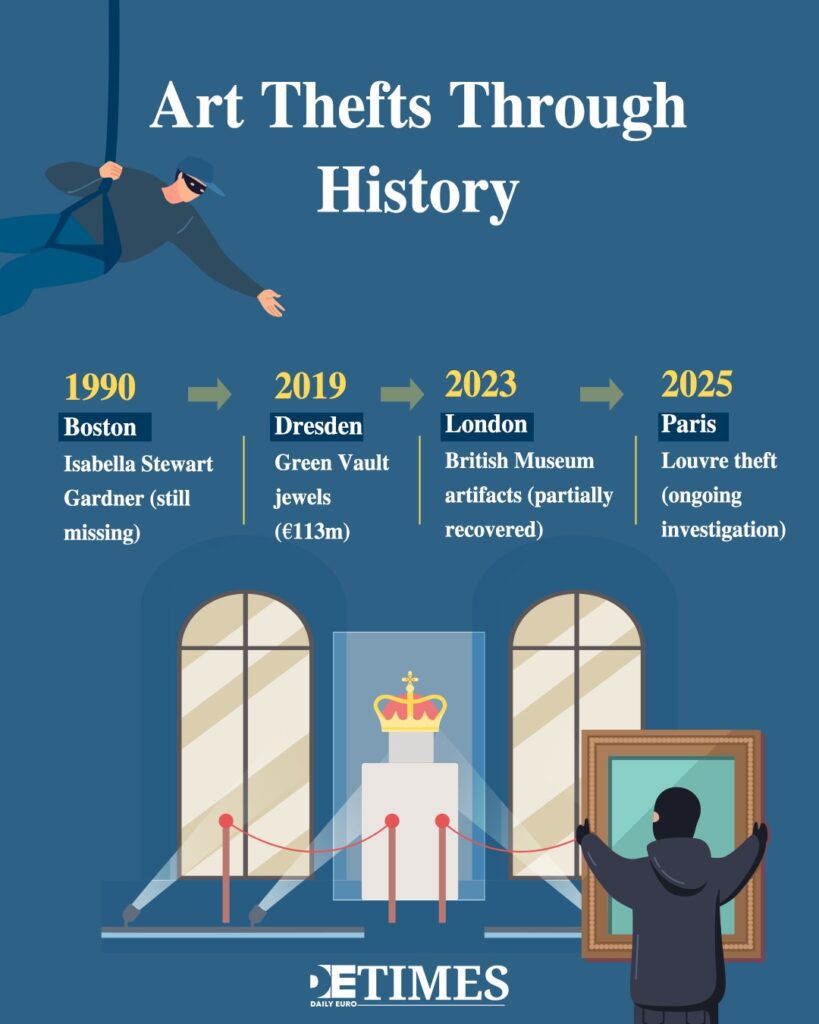The Louvre, usually a symbol of security and grandeur, faced a different kind of spectacle this week. In broad daylight, thieves dressed as staff entered one of the museum’s decorative arts wings and left with jewels once belonging to Empress Joséphine, the first wife of Napoleon Bonaparte. Security footage shows calm precision rather than chaos. Within minutes, history itself was carried out the door.
The stolen pieces date from the early nineteenth century. They include diamond ornaments and a sapphire brooch that once formed part of the imperial collection. Their artistic and historical value is immense, but what makes this heist remarkable is how it unfolded inside one of the most closely watched buildings in the world.

The Fragility of Icons
The Louvre has survived revolutions, occupations, and waves of modernization. Yet even with advanced surveillance and strict protocols, it proved vulnerable. The event feels less like a simple crime and more like a mirror reflecting our uneasy relationship with heritage and power.
These jewels were created to project wealth and permanence. They outlived the empire that commissioned them and found sanctuary in a public museum meant to protect the legacy of the past. Their disappearance reminds us that no monument, however iconic, is beyond human reach.
In a way, the theft dramatizes something museums often try to hide: that they are both temples of preservation and spaces of risk. Behind glass cases and alarms, every artifact depends on trust—the same fragile trust that binds the public to the institutions guarding its shared memory.
The Irony of Royal Treasure
There is a quiet irony in seeing royal jewels stolen not from a palace but from the people’s museum. Once symbols of exclusivity, these ornaments became collective heritage when placed under public care. Now, taken again, they return to the shadows of private possession.
For centuries, art has moved between conquest, collection, and restitution. This time, no empire or army was involved—only deception and opportunity. Yet the symbolism remains potent. The thieves did not just steal gemstones; they stole a fragment of a story France tells about itself: that its treasures, even those of empire, belong to everyone.
What the Heist Reveals
The investigation continues. Police sources describe a highly organised plan, suggesting prior knowledge of museum routines. Experts have already raised concerns that the pieces may be dismantled and sold separately, losing their historical context forever.
But beyond the loss, the heist exposes something deeper: how vulnerable even the most guarded symbols of culture can be. It also tests the idea that museums are neutral, timeless vaults.
In truth, they live and breathe with the same fragilities as the societies they represent.
Perhaps that is what makes the Louvre so human. Beneath its glass pyramid and marble corridors, it holds not only masterpieces but the constant reminder that beauty, power, and history are never as secure as we imagine.
Keep up with Daily Euro Times for more updates!
Read also:
On Trend: Harvard Repatriates Colonial Era Relic to Brazil
Rising Star: Qatar and the MENA Art Market
Leading Cultural Destinations in Qatar






